Climate Tech's Resonant Frequencies
Understanding the secret sauce of successful communication.
👋 Hello to 985 climate buddies - it is getting cozier 🌳
Climate is not a technology problem but a story problem.
Delphi Zero is a consultancy and newsletter about the narrative potential of climate.
“Wow, this really resonates with me.”
Why do we say that? Today’s essay explores the communication science behind resonance.
It is the second piece in a series about storytelling:
Climate Tech’s Resonant Frequencies
By Art Lapinsch (illustrated with Midjourney)
Recently, my friend Steven - writer of two climate-focused Substacks - asked me:
Do you think the climate communication space is overcrowded?
🤔
The short answer: I don’t think so.
Here’s why 👇
Differentiation Through Uniqueness
Back in 2021, I pretended to be an online course creator.
I spent two months learning from and with some of the best online course creators. Think of online cohorts, video courses, email-based courses, in-person training, etc.
Yet, one realization hit me like a truck: Some of the most successful colleagues were teaching exactly the same thing.
Thomas Frank (~3M YouTube subscribers), August Bradley (~65k YT subs), Marie Poulin (~40k YT subs), and Daniel Canosa (~7k YT subs).
All of them were teaching “How to use Notion”.
How could they build successful businesses by selling “the same niche courses”?
The answer is that all of them are unique people.
Thomas was a student productivity influencer before becoming a YouTube star, August produced award-winning music videos for metal bands, Marie is a permaculture expert and an ADHD advocate, and Daniel was living the digital nomad lifestyle.
Their unique perspectives influenced how they interacted with the world. As a result, the same product (i.e. “how to use Notion” courses) was taught in vastly different ways.
Commoditized products suddenly become differentiated products.
A single mom would rather learn from another single mom than from a tech bro.
This is due to resonance.
The Mother of All Models
To understand resonance, we need to look at the famed “mother of all models” - the Shannon-Weaver Model of Communication.
Published in the 1940s, this model still applies to communication and signal flows.
👩🦱 Information Source (= Sender): Who is communicating?
💡 Message (= Information): What are they trying to communicate?
📞 Transmitter: How is the message translated into a signal?
📶 Signal: What type of signal does the transmitter produce?
📞 Receiver: How is the signal translated back into a message?
👨🦰 Destination (= Audience): Who is paying attention?
A few additional components of the model are:
✉️ Channel (= Medium): Through which medium does the signal travel?
🚧 Noise: What is disturbing the quality of the signal?
Tim Urban’s explains human conversation like this (bold = my annotation/highlight):
Back to us and hearing. Ears (= receiver) are an evolutionary innovation that allows us to register sound waves in the air around us (= signal) and process them as information—without ears, most sound waves would be imperceptible to a human with only the loudest sounds registering as a felt vibration on our skin. Ears give us a magical ability to sense even slight sound waves in a way so nuanced, it can usually tell us exactly where the sound is coming from and what the meaning of it is. And it enables us to talk. The most important kind of human communication happens when our brains send information to other brains through complex patterns of air pressure waves. Have you ever stopped and thought about how incredible that is?
I was about to move on, but sorry, I can’t get over this. The next time you’re (= information source) talking to someone, I want you to stop and think about what’s happening. Your brain has a thought (= message). It translates that thought into a pattern of pressure waves. Then your lungs send air out of your body, but as you do that, you vibrate your vocal chords in just the right way and you move your mouth and tongue into just the right shapes that by the time the air leaves you (= transmitter), it’s embedded with a pattern of high- and low-pressure areas (= signal). The code in that air then spreads out to all the air (= channel) in the vicinity, a little bit of which ends up in your friend’s (= destination) ear (= receiver), where it passes by their eardrum. When it does, it vibrates their eardrum in such a way as to pass on not only the code, but exactly where in the room it came from and the particular tone of voice it came with. The eardrum’s vibrations are transmitted through three tiny bones and into a little sac of fluid, which then transmits the information into electrical impulses and sends them up the auditory nerve and into the brain, where the information is decoded. And all of that happens in an eighth of a second, without any effort from either of you. Talking is a miracle.
Finding the Resonant Frequency 📻
“That resonated with me.”
“Wow, this story really resonates.”
If you’ve ever said something along these lines then you know what I’m talking about.
Resonance is a feeling of familiarity. A feeling of understanding. A feeling of being on the same wave length.
But what’s the science behind it?
Hitting Resonant Frequencies
This is what happens when a bridge resonates with its environment (in a literal sense).
Without pretending that I understand the physics behind resonant frequencies, there’s still one important takeaway: Resonance happens when two things are on the same wave length 📻
My friends’ Notion courses resonated for different reasons:
Thomas teaches Notion as a system to learn faster.
August teaches Notion as a system to run a business.
Marie teaches Notion as a system to structure the chaos of everyday life.
Daniel teaches Notion as a system to organize the nomadic freelancer lifestyle.
They found their tribes.
💡 Fun fact: According to Harvard, the resonant frequency of humans is somewhere between 5-10Hz.
The Fundamentals of Resonance: Encoding and Decoding
The Shannon-Weaver model looks very similar for my four online teacher friends:
Sender: Online teacher
Message: How to use Notion
Transmitter: Computer with video camera and internet connection
Signal: Data package on the internet
Channel: Internet video
Receiver: Computer with a screen
Destination: Online student
So where exactly is the magic sauce?
The magic happens when the sender encodes the message in a way that the receiver can decode it.
Encoding and Decoding the Signal 📻
Think of an FM radio.
My favorite radio station sends (encode) funky tunes on the 98.2 FM frequency (= signal). If my radio is set (decode) to 98.2 FM, I can bop my head to the voice of James Brown.
The radio station (transmitter) and my radio (receiver) are on the same wave length.
Encoding and decoding the same signal is a necessary precondition for resonance.
If I resonate with funky music, then I need to be able to decode the encoded message. Without setting my radio frequency to 98.2 FM I will not be able to enjoy James Brown.
Encoding and Decoding the Message 💡
The language of the audience is shaped by many things: cultural upbringing, personal and professional experience, reinforced biases, etc.
Figuratively, this means that when we communicate, we should be well aware of how messages are interpreted/decoded.
Currently, my best hypothesis is that resonance happens when we communicate ideas in a shared language that our audience understands.
Resonant Frequencies of Messages and Signals
To summarize, resonance requires encoding and decoding to be synchronized across two stages:
Message: Sender and receiver use same language → What
Signal: Sender and receiver use same signal → How
Climate Tech’s Resonant Frequencies
It might seem that in our own tiny information bubbles (e.g. tech entrepreneur; climate VC; academic circles; civic leaders; policymakers; etc.) there are already many voices spreading the gospel.
But my assumption is that we are only aware of a subset of the total messages floating around in the ether.
Luckily, we are not everybody. There are many people who can and should learn about climate. Most likely, they will resonate with other voices who speak their language.
[broad] MyClimateJourney resonates with people getting into climate
[narrower] Climate Papa resonates with parents who want to learn about climate
[super narrow] Intercalation Station resonates with professionals in the battery industry
Here’s a list of my favorite climate writers on Substack. And that is just my perspective.
There are many more out there.
Practical Consideration #1: Get Started
In Silicon Valley they say “If you build it, they will come.”
To paraphrase it: “If you write/record it, they will/watch read.”
In step one, you have no idea who your audience is. Be patient and see who resonates with your unique way of communicating.
Once you have a small audience, you can start identifying patters:
Who: Who is in the audience? What markers do they share?
How: How do they communicate? What language do they use?
What: Which topics/ideas/areas are they interested in?
Why: What drives them?
Practical Consideration #2: Iterate
In reality, communication is a feedback loop.
The more you can answer the questions about your target audience, the better you can tailor your communication (message, encoding, channel, etc.) to their needs.
You interact with the world and then you learn. Rinse and repeat.
This applies to writing, content marketing, branding, etc.
Practical Consideration #3: Find Your Resonant Frequencies
Initially, when someone starts communicating about climate, they ask: “What should I talk about? Hasn’t everything been said already?”
Yes and no.
Yes, because most likely, you are not the first one to talk about the greenhouse effect and decarbonization paths.
No, because most likely, you might have just the right perspective for an underserved audience.
Do you think the climate communication space is overcrowded?
The slightly longer answer: I don’t think so. I don’t think we have a saturation problem. I think we have a supply problem.
Putting my licked index finger in the air, I would guess that 95%+ of people are not yet actively involved with climate. There is a looooooooooooooooot of room for growth.
Some people like to read books. Some like to watch TikToks.
Some use academic terminology. Some like TL;DR.
Different things resonate with different people. And since climate change is a systemic problem, we need all of them to get along for the ride.
Let’s do that by catering to their resonant frequencies.
🙏 Thanks, Steven, Prof. Ben, Lukas, for inspiring and discussing.
Why do I write about this stuff? Because it’s probably the thing I know best.
If you want to dive deeper, check out my previous communication-themed essays about consistent brand narratives and leveraging emotional comms.
Here’s an overview of my most popular writing.
If you want to reach out, collaborate, or discuss, ping me via mail or Linkedin.













Loved this. It resonated. :)
"This really resonates with me" 😂
It's true, that the same messages needs to be repeated, and also shared by different senders to sink in